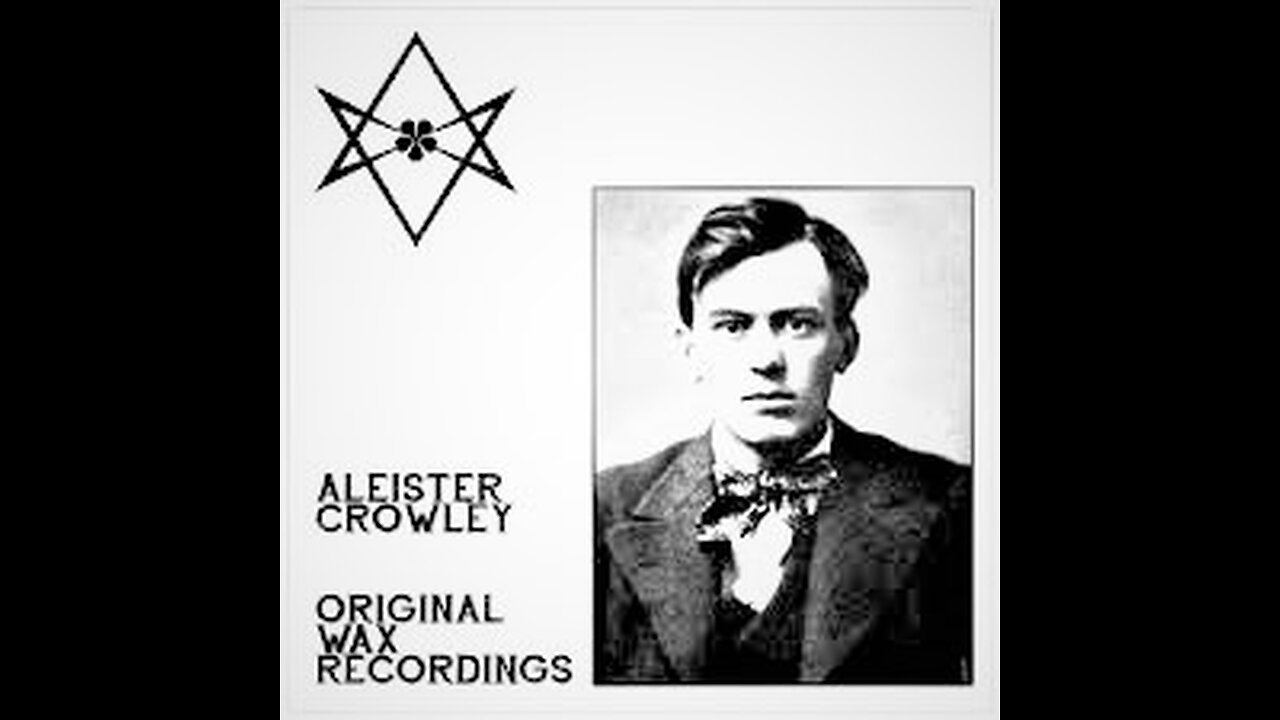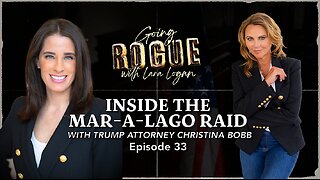Premium Only Content

Aleister Crowley in Switzerland Censorship
THE ORIGIN OF THE SATANIC CULT IS IN SWITZERLAND
He made the first attempts on K2 and Kanchenjunga, and was a visionary rock climber putting up difficult routes in the late 1800s, but his climbing later took a backseat to his unsavory reputation as an occultist and sex fiend.
February 22, 2022
This article is part of Climbing’s ongoing Who’s Who biographical study of climbing’s all-time greats, achievers, and, in the case of Aleister Crowley, most notorious.
Alex Honnold
Tommy Caldwell
Adam Ondra
Janja Garnbret
George Mallory
Sir Edmund Hillary
Brooke Rabourtou
John Gill
Daniel Woods
Jeff Lowe
Aaron Ralston
Jon Krakauer
Tenzing Norgay
Dean Potter
Aleister Crowley (October 12, 1875 – December 1, 1947), was an English mountaineer, more commonly known as an occultist and the founder of the Thelema religious movement. He was also a prolific novelist, playwright, poet, and painter.
While most of his writing involved Thelema and “magick” (a term Crowley popularized to refer to occult magic, as opposed to performance magic), he also wrote about philosophy, culture, and politics, and was an active social critic.
His tumultuous life, lurid sexual adventures, extensive drug use, and esoteric spiritual practices, sometimes involving blood sacrifice, among other methods, led him to achieve widespread notoriety as a counterculture figure, as well as the moniker “the wickedest man in the world.”
While his climbing accomplishments are lesser-known, Crowley is notable as the first Westerner to attempt K2 (8,611 meters), in 1902, with Oscar Eckenstein, and for leading an attempt on Kanchenjunga (8,586 meters). The latter expedition, although also unsuccessful, purportedly reached the highest point that any human being had achieved on any mountain at the time (7,620 meters/25,000 feet). Both peaks were not summited until over 50 years after Crowley’s attempts.
Aleister Crowley with climbing teammates in 1902
1902: English author, occultist, magician and mountaineer Aleister Crowley (1875 – 1947) (second from left) with companions during an expedition. (Photo: Picture Post/Hulton Archive/Getty Images)
Early Life and Climbing
Aleister Crowley, originally Edward Alexander Crowley, was born into a wealthy and devout fundamentalist Christian family in Warwickshire and was sent to an evangelical boarding school at the age of eight. By his teenage years, however, he had begun to rebel against his strict Christian upbringing, arguing with his tutors about inconsistencies in the Bible and delving into the occult, as well as smoking, openly masturbating, torturing animals, spiking school meals, and having sex with prostitutes.
By the time he was 19, he had changed his name to “Aleister,” and had also become interested in chess and mountaineering, joining the Scottish Mountaineering Club in 1894. He became an early pioneer of balance-based climbing, and was an active climber in the Lake District throughout the 1890s, completing a solo ascent of the Napes Needle, among other formations. He also achieved fame for first ascents on lines such as Devil’s Chimney, Etheldreda’s Pinnacle, and the now-legendary Cuillin Crack on the chalk cliffs at Beachy Head (the latter line took almost a century to see a repeat).
Crowley entered Trinity College at Cambridge in 1895, where he became president of the chess club and further immersed himself in the British mountaineering scene. He embarked on successful climbing trips in the Swiss Alps, summiting the Eiger (13,015 feet), Wetterhorn (12,113 feet), Jungfrau (13,642 feet), and Mönch (13,480 feet), among other peaks, though he left Cambridge without a degree in 1898.
Crowley also penned one of the world’s earliest bouldering guides, dated 1898, in the Wasdale Head Inn’s—the birthplace of British climbing—visitor’s book, accompanied by a drawing from L. A. Legros. The guide covered over a dozen individual problems on Wasdale’s now famous “Y-shaped boulder,” in addition to specifying a variety of eliminates (“may not use the edges,” “may not use the slab for handhold,” etc.
By his mid-20s, Crowley’s dissatisfaction with Christianity had turned into an active interest in the occult, and in 1898, he joined the esoteric Hermetic Order of the Golden Dawn, a secret society dedicated to the practice and study of the occult and paranormal, becoming trained in ceremonial magic.
Amid a wild string of travels (made possible by a multi-million dollar inheritance) from Sweden to India to Russia to Sri Lanka to Japan to honeymooning with his first wife, Rose Edith Kelly, in Egypt (where he was purportedly contacted by a deity named Aiwass, who provided him with a sacred text that served as the basis for his religion, Thelema), Crowley also embarked on a mountaineering trip to Mexico with Oscar Eckenstein, now known as the inventor of the modern crampon.
Eckenstein was one of Crowley’s only climbing partners, but held the latter in high regard. In Eckenstein’s autobiography, Confessions, he wrote of Crowley’s boundless gymnastic strength, including his ability to do one-arm pull-ups.
Aleister Crowley (1875-1947) english mystic, black magus in Victorian England, founder of the cabbala, here in 1902 (Photo: Getty Images)
In Mexico, the duo managed summits of Iztaccíhuatl (17,160 feet) and Popocatépetl (17,802 feet), the country’s third and second-highest peaks, respectively. They also embarked on failed attempts to Volcán de Colima (12,533 feet), which erupted while the pair were on it, and Pico de Orizaba (18,491 feet), Mexico’s tallest peak.
K2 and Kanchenjunga Expeditions
Crowley and Eckenstein made the first attempt on K2 in 1902, along with Guy Knowles, Jules Jacot-Guillarmod, Heinrich Pfannl, and Victor Wessely. The group planned to reach the summit via the Northeast Ridge, but the expedition was a veritable disaster.
Weather was abominable, with a mere eight of the 68 days spent on the mountain offering viable windows. Crowley was afflicted with a combination of influenza, malaria, and snow blindness, in addition to severe altitude sickness, while Eckenstein, the leader, battled a respiratory infection. At one point, Crowley, delirious with fever, threatened Knowles with a revolver when the latter refused to continue. Perhaps surprisingly, all members returned unscathed.
Crowley, after the expedition, expressed a belief that not the Northeast Ridge, but the Abruzzi Spur (Southeast Spur), was likely the best line of ascent. When K2 finally fell to an Italian team over half a century later, in 1954, the Abruzzi was the route used, and it has since become the standard route on the mountain.
Crowley attempted another 8,000-meter peak, Kanchenjunga, in 1905, via the southwest face over the Yalung Glacier. He led a team consisting of Jacot-Guillarmod, Alexis Pache, Charles-Adolphe Reymond, and Alcesti Rigo de Righi.
English writer and occultist Aleister Crowley (1875 – 1947). (Photo by Keystone/Getty Images)
This expedition, too, went poorly. Crowley was immensely arrogant as a leader, earning the ire of his fellow climbers, and behaved abominably toward the porters, beating them on several occasions, which caused him to come to odds with Jacot-Guillarmod in particular. After being caught in an avalanche at what Reymond reported to be 21,300 feet (though, as noted, Crowley claimed to have reached much higher), Jacot-Guillarmod and De Righi led an unsuccessful coup against Crowley, arguing for him to be removed from leadership.
Then the duo, along with Pache, retreated from Camp V (20,300 feet) along with four porters, though Crowley advised against descending at night. The rope team was soon struck by an avalanche that killed three of the porters and Pache, but although Reymond, the last remaining team member, immediately descended from Camp V to help, Crowley stubbornly stayed in his tent, ignoring the cries of the survivors.
He later penned a letter to an Indian newspaper evincing his scorn for his companions, writing that “a mountain, “accident of this sort is one of the things for which I have no sympathy.” The following day, on his descent, he passed the site without stopping to help in body recovery efforts or speaking to any of the survivors. He went on to abscond with the remains of the expedition’s funds in Darjeeling.
The mountain was eventually summited in 1955 by a British team, using the same route Crowley and his companions had pioneered 50 years prior.
Later Life
Kanchenjunga was the last serious climbing endeavor Crowley undertook, and his behavior on the mountain led to his reputation in the climbing community deteriorating dramatically, even in the eyes of his former friend Eckenstein.
Crowley spent the majority of his later life immersed in the occult, traveling widely, promoting Thelema, and practicing magick, bogged by opium addiction and a number of health afflictions. Crowley died in England in December of 1947, at the age of 72, from chronic bronchitis.
Aleister Crowley Climbing Accomplishments
Despite his poor reputation, Crowley’s accomplishments as an alpinist were significant for the time. In addition to his unsuccessful expeditions on K2 and Kanchenjunga, he successfully climbed several peaks in the Alps and put up a string of hard first ascents on rock in the Lake District and Beachy Head, as well as other sites in the United Kingdom, during the 1890s. A short list of summits follows.
Eiger (13,015 ft), Bernese Alps, Switzerland
Wetterhorn (12,113 ft), Bernese Alps, Switzerland
Jungfrau (13,642 ft), Bernese Alps, Switzerland
Mönch (13,480 ft), Bernese Alps, Switzerland
Dent Blanche (14,298 ft), Pennine Alps, Switzerland
Matterhorn (14,692 ft), Pennine Alps, Switzerland
Iztaccíhuatl (17,160 feet), Trans-Mexican Volcanic Belt, Mexico
Popocatépetl (17,802 feet), Trans-Mexican Volcanic Belt, Mexico
6 Places Aleister Crowley Performed His Satanic Ceremonies
A guide to traveling with “the wickedest man in the world.”
Born in the late 1870s, England, Aleister Crowley was one of the great characters of the 20th century—a poet, a magician, a journalist, an alchemist, a philosopher, a spy, a self-affirmed drug fiend, and a sex addict. He was also known as “The Great Beast” and the “wickedest man in the world.” He played a major role in the creation of alternate religions like Wicca, the A∴A∴, and the Ordo Templi Orientis, and he founded the Order of Thelema, a semi-Satanic cult whose famous edict was “do what thou wilt.”
Crowley is to the occult as Tolkien is to fantasy—he set the stage that everyone else plays in. Basically, if you’re dabbling in things dark and dastardly, Aleister was probably there first.
In all of his doings, Crowley traveled a lot. He pursued exploits in Egypt, India, the Far East, Australia, all over Europe and North America, dotting the map with sex magick and weird stunts. Here are a six places in the Atlas where the infamous occultist left his mark.
Blythe Road, the former site of the London temple of the Hermetic Order of the Golden Dawn. (Photo: Philip Perry/CC BY-SA 2.0)
Though he was interested in the occult from childhood, Crowley’s first foray into organized magic (or “magick,” as he preferred to spell it) was with the Hermetic Order of the Golden Dawn. Well liked by its co-founder, Samuel Liddell MacGregor Mathers, Crowley advanced in the ranks very quickly. However, not everyone was a fan. The London chapter, which had already found faults in Mathers’ leadership, particularly disavowed him for the eccentric, bisexual Crowley. This caused a decisive rift between two factions of the Order, but Mathers wasn’t ready to concede his leadership.
In 1900, while the poet and London chapter leader W. B. Yeats was heading a meeting, he was attacked by an “astral siege” from none other than Aleister Crowley. Crowley, wearing a black Osiris mask and a kilt, and his mistress burst into the temple, casting spells and brandishing daggers. They intended to take the temple for Mathers’, but were unsuccessful. The police came, the scuffle went to court, and the London chapter of the Golden Dawn won (as they paid the rent on the space). Now the nondescript George’s Cafe resides in the former site of the secret society’s temple, with no indication of its former life.
2. Boleskine House
INVERNESS, SCOTLAND
Boleskine House was steeped in darkness long before Crowley moved in. The manor is allegedly built atop the ruins of a 10th century church that burnt to the ground during a service, killing all the congregants inside. Crowley bought Boleskine House to seclude himself and perform magic from The Book of Sacred Magic of Abramelin the Mage. It was during this period that Crowley became famous for his occultism and black magic, both around the Scotland and later, the world. Sometime during this period Mathers called Crowley to Paris. He left without dispelling the “12 Kings and Dukes of Hell” he had summoned, and many locals blame the house’s unlucky history on evil spirits left behind.
First, Crowley’s housekeeper’s two children died mysteriously and abruptly. Crowley also bragged that one employee of the estate who had long abstained from alcohol got drunk and attempted to murder his entire family. After the house had changed hands, it still wasn’t free of dark energy. In 1965, the army major who owned the house committed suicide by shotgun. The next owner, Led Zeppelin’s Jimmy Page, spent very little time at the estate, instead bequeathing it to a friend who didn’t mind the unexplained creaks, groans, and various ghostly apparitions, but was bothered by the Crowley and Page fans who frequently attempted to break into the house and defile the grounds. Later owners dismissed any notions of hauntings or witchcraft at the house, but in 2015, the residents returned from a shopping trip to find the house completely in flames.
3. Crowley’s Magickal Retirement
HEBRON, NEW HAMPSHIRE
New Hampshire site of Aleister Crowley's magickal retirement.
In 1916, Crowley spent four months at the home of renowned medium Evangeline Adams in what he called a “magickal retirement.” This didn’t mean taking a break from cocaine, heroin, sex magick, and prolonged rituals. Quite the opposite in fact. In Hebron, Crowley doubled down and did a great deal of writing, poetry and magical instruction alike. He was even a ghost writer on several of Adams’ books of astrology.
4. Esopus Island
HYDE PARK, NEW YORK
Esopus Island viewed by boat.
Esopus Island viewed by boat. (Photo: Map data ©2016 Google)
In another magickal retreat, Crowley spent 40 days and 40 nights (a la Jesus Christ) on a tiny island in the Hudson River. His mission was translating the Tao Te Ching, a 4th century Chinese philosophical text.
He hadn’t brought much food but had packed plenty of red paint, and also put himself to work painting Thelemic graffiti on the island’s rocks.
Curious families watching the bald, robed man on the island from the banks of the Hudson began bringing him rations.
He was also visited by fans and artists, who brought him food, drugs, and company.
Much later Crowley reported experiencing visions of his past lives during his stay on Esopus Island, all of which were somehow very influential figures.
His former selves included legendary Taoist Ge Xuan, Renaissance Pope Alexander VI, alchemist Alessandro Cagliostro, and the magician Eliphas Levi. Today, the island is open to the public so long as they can reach it by boat.
There are even camping amenities for those who wish to follow in the footsteps of the infamous occultist.
5. Boca do Inferno
CASCAIS, PORTUGAL
Opening to a cave at Boca do Inferno.
The mouth of a cave at Boca do Inferno. (Photo: Beatrizpereirap/CC BY-SA 3.0)
Any eccentric worth his salt has to fake his own death at least once. When visiting Portugal in 1930 and feeling annoyed by his current mistress, Crowley gave appearance he had committed suicide at the Boca de Inferno (“Mouth of Hell”) caves.
His friend, poet Fernando Pessoa handed Crowley’s suicide note to newspapers, helpfully explaining the magical symbols and translating the mangled Portuguese to police and media alike.
Three weeks later, Crowley reappeared at the opening of an exhibition of his works in a Berlin gallery, suggesting this whole affair was more publicity stunt than anything else.
Today, there is a small white plaque mounted on the rock provides the text of Crowley’s note:
”Não Posso Viver Sem Ti. A outra ‘Boca De Infierno’ apanhar-me-á não será tão quente como a tua,” which translates roughly to “Can’t live without you. The other mouth of hell that will catch me won’t be as hot as yours.” That might be touching if any of it were genuine.
6. The Abbey of Thelema
CEFALÙ, ITALY
Decay in the Abbey of Thelema, Cefalù, Sicily.
Decay in the Abbey of Thelema, Cefalù, Sicily. (Photo: Frater Kybernetes/CC BY-SA 2.0)
Crowley’s magickal career came to its peak in a little Sicilian town. For a small amount of money, he, his two lovers, their small children, and miscellaneous followers moved into one story house facing the Mediterranean sea.
They called it the Abbey of Thelema.
The common room was dedicated to ritual practices and held a scarlet “magick” circle marked with the sign of the major Thelemic deities. Crowley’s own bedroom, labeled by himself as ”la chambre des cauchemars” (or “the room of nightmares”) was entirely hand-painted by the occultist with explicitly erotic frescos, hermaphroditic goblins, and vividly colored monsters.
This private room was used for specific night initiations involving psychoactive drugs which gave terrifying cinematic life to this Bosch-like vision of hellish debauchery.
Crowley considered his temple a school of magick, and gave it an appropriately collegiate motto: “Collegium ad Spiritum Sanctum”—“A College towards the Holy Spirit.” The Cefalù period was one of the most prolific and happy of his life, even as he suffered from drug addiction and had to write the scandalous Diary of a Drug Fiend to finance his community.
The growing interest in dark magic and the occult provided him with an ample student body (pun intended). But in 1922, the experience in monasticism ended when Raoul Loveday, a young disciple, tragically died from typhoid fever contracted from drinking contaminated spring water, though Loveday’s wife maintained it was from drinking cat’s blood.
Crowley and his people were evicted by Mussolini’s regime in 1923. The dictator had no sympathy for pornographic art or mysticism. Once the Abbey closed, the villagers whitewashed the murals, which they somewhat correctly saw as demonic. This erased much of the history and work of Crowley in Cefalù. The Abbey of Thelema is still there, a hidden monument of mysterious, magickal decay.
Aleister Crowley and the Link Between Occultism and Espionage
The first is a serious endeavor undertaken by governments to gain vital information about their enemies and about threats against their countries, while the second is considered paranormal mumbo-jumbo.
But one man bridged the two in real terms and claimed to accomplish some incredible feats. Let’s find out more about this man
Spy agencies are bureaucratic secret societies that aim to acquire the secrets of others, and conceal their own. The pursuit of occult knowledge is quite similar.
Aleister Crowley: Con Man
Edward Alexander Crowley, better known as Aleister Crowley, has been dubbed by some as ‘the wickedest man in the world’, but he preferred to call himself ‘The Great Beast 666’.
To some, he was a faker and a con man; to others, he was a spiritual master and misunderstood genius. Regardless, Aleister Crowley was undoubtedly the most influential occultist of the 20th century. And he was also something else: a spy. In fact, Crowley was an agent provocateur—an agent who gains the enemy’s confidence and influences them to commit illegal or self-defeating acts.
Learn more about the real history of secret societies.
Connecting the Occult and Espionage
Crowley intertwined secret societies, occultism, and espionage in a way that hadn’t been done before. The secret society–occult interplay seems obvious enough. The connection with intelligence agencies is a little harder to figure.
Basically, spy agencies are bureaucratic secret societies. Their aim is to acquire the secrets of others, and conceal their own. They’re selective in recruitment, and bind members by oaths of silence. They prefer to operate outside of public awareness and scrutiny.
The pursuit of occult knowledge is quite similar. As Crowley put it: “Investigation of spiritualism makes a capital-training ground for secret service work; one soon gets up to all the tricks.” It’s not by accident that intelligence professionals are commonly nicknamed ‘spooks’.
Espionage has its own moral code. One British agent recalled being told—at the time of his recruitment—that “you mustn’t be afraid of forgery and you mustn’t be afraid of murder”. Crowley’s personal motto of “Do What Thou Wilt” fit perfectly.
While popular imagination connects the occult with the supernatural, or diabolical, it really just means ‘concealed’.
An occultist seeks to reveal what is hidden, and, as often as not, re-conceal it.
A cardinal rule in secret societies is that the knowledge such organizations offer isn’t for everyone.
It’s for the elect, and part of the elect’s job is to keep it to themselves.
Learn more about Aleister Crowley, occultism, and espionage.
Who Exactly Was Aleister Crowley?
Crowley is commonly regarded as a Satanist, though that’s highly debatable. Despite occasional claims to Irish ancestry, he was entirely English. Crowley came from a well-to-do, fundamentalist Christian home. That inspired his desire to start a new religion.
He cobbled his mystical experiences and pet beliefs into something he dubbed ‘Thelema’; or ‘Will’. Others called it ‘Crowley-anity’. He dreamed it would push aside Christianity, and usher in a new age of enlightenment. He was also a world-class mountain climber, and chess player.
Crowley’s occultist career began when he joined the Hermetic Order of the Golden Dawn in 1898. The Golden Dawn was among the many esoteric societies that popped up like mushrooms in the 1880s. Its notable members included poet William Butler Yeats, and occult scholar Arthur Waite.
From the outside, it seemed like a late-Victorian gaggle of well-heeled crackpots and eccentric artists. But some members of this secret society harbored a political agenda. It was called Legitimism.
In practical terms, it meant getting people like Queen Victoria—a German descendant—off the British throne, and restoring the rightful Stuart line. It promised to return England to the bosom of the Roman Catholic Church, and restore autonomy to Scotland and Ireland.
No surprise then that the Golden Dawn had more than its share of Irish members, such as Yeats. Some had ties to the Irish Republican Brotherhood, which was a secret society fighting for Irish independence.
One leader of the Golden Dawn—the very man who initiated Aleister Crowley—was a British occultist and Legitimist named Samuel MacGregor Mathers. In turn, Mathers was the close friend of a peculiar English peer named Lord Bertram Ashburnham.
Ashburnham was also a militant Legitimist who operated an armed training camp on his estate. In fact, Mathers, Ashburnham, and other Golden Dawners were neck-deep in a conspiracy to arm and finance a revolution in Spain. Once successful, they expected the new king, one Don Carlos, to return the favor.
Learn more about secret societies: the underworld of history.
British Intelligence Sent Crowley to Infiltrate the Golden Dawn
It’s not hard to see why the British authorities wanted to know what was going on at those lodge meetings. The man they sent to find out was Aleister Crowley. With Mathers’ backing, Crowley wormed his way into the Spanish plot, which included smuggling a shipload of arms. Someone—probably Crowley—betrayed it.
A man with black unruly hair and black long beard bathing in a spring, the rocky bank of the spring can be seen behind him, his face is much darker than the rest of his body.Aleister Crowley proved to be disruptive in Golden Dawn and eventually sparked an internal feud that all but destroyed the Golden Dawn. (Image: Jules Jacot Guillarmod/Public domain)
His joining the Golden Dawn was like tossing a grenade into the room. Crowley’s theatrical flamboyance ruffled feathers. He stirred up more trouble by introducing sex into some of their rituals. The result was an internal feud that all but destroyed the Golden Dawn. And that probably suited Crowley’s employers just fine.
A key element in the Golden Dawn’s belief system—and Crowley’s—was a group known as the secret chiefs. They were thought to be advanced spiritual beings who mysteriously guided their initiates; turning revelation on and off like a spigot. Interestingly, Crowley compared them to spy chiefs for their tendency “to keep us in the dark”.
The secret chiefs were served by their own secret society, the Great White Lodge. Appropriately, the White Lodge opposed an insidious group known as the Black Lodge and its Black Brothers. The distinction was between white and black magic. Just about everyone Crowley disliked—and there were many—he branded a Black Brother. Despite his reputation as a black magician, Crowley insisted that he really served the White Lodge.
This is a transcript from the video series Secret Societies. Watch it now, Wondrium.
Thwarting a Possible Irish Uprising
About 15 years after the Golden Dawn episode, an important Irish nationalist known as Sir Roger Casement visited New York City to negotiate a secret deal for German support of an uprising in Ireland. British intelligence caught wind, and proceeded cautiously.
America was a neutral country, and the Irish cause enjoyed wide support there. But the Brits knew a secret: Casement was a homosexual, and that offered a means to entrap and compromise him.
Crowley was, or affected to be, bisexual. His ability to infiltrate the gay underworld made him ideal to unofficially dig up dirt on Casement. If Crowley was exposed, London’s hands were clean. It’s called deniability.
When Crowley sailed from England, the British believed that Casement was still in New York. But he’d quietly slipped away. So, Crowley arrived in Manhattan to find his ‘egg was addled’. But he found other ways to be useful.
On July 3, 1915, as the first rays of dawn reflected off the Hudson River, 10 people gathered on the 50th Street Pier. Leading them was Crowley himself, acting as self-proclaimed ‘leader of Irish hope’ and a representative of the ‘Secret Revolutionary Committee of Public Safety of the Provisional Government of Ireland’.
Of course, that was an organization that existed only in Crowley’s imagination. Two others in tow were bona fide Irish nationalists, but four were just common drunks. Another in attendance was Crowley’s then current girlfriend—or ‘scarlet woman’—named Leila Waddell. She kept everyone entertained, or at least awake, with lively fiddle tunes.
Also on hand was a reporter from The New York Times. Crowley wanted to be sure the event got plenty of publicity. After rowing out to Liberty Island, he went into high gear, swearing an oath to revolution, and ostentatiously tearing up his British passport. He next ‘declared war’ on England, and swore to fight to the last drop of his blood for Irish freedom. It was pure theater.
Crowley later admitted he “knew almost nothing” about Ireland, or its struggle for independence. His real passport was safe back in his room. He’d torn up an envelope. Nor was he really trying to impress the Irish revolutionaries in New York. The Germans were his target.
Drawing the United States into World War I
The chief German propagandist in New York—a man named George Sylvester Viereck—had hired Crowley to write anti-British articles for his magazine, The Fatherland. Handily, Viereck was an aspiring occultist and a secret society member with a fondness for drugs and orgies.
Through Viereck, Crowley gained the ear of the so-called ‘Propaganda Kabinett’. This was a secret group that included German-American journalists and academics, as well as German officials like the Kaiser’s military attaché in Washington, Franz von Papen. Eighteen years later, von Papen would be one of the men who made Adolf Hitler the chancellor of Germany.
As much as the British wanted to draw the United States into the war, the Germans wanted to keep them out. The question was, how?
A large ocen liner slowly sinking with thick, dark plumes of smoke rising up from its hull, while several boats are rescuing passengers who have gone overboard, and a few rescue boats are near the sinking ship as well.Crowley claimed that he was able to influence the German Propaganda Kabinett during a March 1915 meeting to believe that “arrogance and violence were the best policy”, which led to a German U-boat torpedoing the British Ocean Liner RMS Lusitania off the coast of Ireland on May 7, 1915, and killing over 1,000 people. (Image: Everett Collection/Shutterstock)
Crowley said that at a March 1915 cabinet meeting, he “gradually got the Germans to believe that arrogance and violence were the best policy”. The Americans, he explained, were like children; easily frightened and responsive to firmness. Crowley bamboozled the Germans into believing that his study of the occult gave him insight into the mass psychology of the Americans and British.
The big topic of discussion that day was the ocean liner The Lusitania. The vessel was the pride of the British liner fleet. The Germans knew it was being used to ferry war supplies from New York to Liverpool. That made it a military target, but the sticking point was that there were hundreds of innocent passengers on board.
Would the propaganda benefit from sinking the Lusitania be offset by the negative publicity? Crowley argued that it wouldn’t.
The Propaganda Kabinett forwarded his opinion to Berlin. And, on 7 May 1915, a German U-boat torpedoed The Lusitania off the coast of Ireland, and over 1,000 people perished. Though the United States wouldn’t join the war for two more years, Germany’s reputation was now thoroughly blackened in the eyes of much of the American public.
Learn more about mafia, the criminal secret societies.
Crowley Played for All Sides
Some have claimed that Crowley grossly exaggerates his influence. That might be true, but it would equally incorrect to say that he didn’t have any influence. The real key to Crowley gaining German confidence wasn’t Viereck but “a man high in the German secret service” named Theodor Reuss.
Before World War I, Reuss had worked in London as a journalist. He was also a secret society initiate and a spy. Reuss pitched the Ordo Templi Orientis, or OTO—of which he was a member—as a one-stop occult super store.
Starting in Germany around 1903, the OTO aspired to unify other esoteric societies under its banner. Its claimed affiliates included the Illuminati, the Knights Templar, the Masonic Rite of Memphis-Misraim, and the Rosicrucians. More importantly, perhaps, the OTO served as a cover for German intelligence.
In 1912, Reuss initiated Crowley into the OTO in Berlin. Crowley then became chief of the order’s operations in English-speaking countries. He even got a new mystical name, Baphomet, which was the idol supposedly worshipped by the Knights Templar.
Whether Reuss simultaneously enlisted Crowley into German intelligence—or thought he did—is another question. Regardless, he and Crowley maintained clandestine contact throughout World War I, while Crowley secretly worked for Britain in America, and as Reuss served as the Kaiser’s agent in Holland and Switzerland.
After Reuss died, Crowley later managed to grab control of the OTO, or a faction of it. And the OTO is still very much alive, along with accusations that it’s linked to intelligence activity.
Common Questions about Aleister Crowley, Occult, Secret Societies and Espionage
Q: Who is considered the most wicked man in the world?
A section of people called Aleister Crowley ‘the wickedest man in the world’, but he preferred to call himself The Great Beast 666.
Q: When was the Golden Dawn founded?
The Hermetic Order of the Golden Dawn (or just Golden Dawn) was founded in 1887 and was among the many esoteric societies that popped up in the 1880s. Its notable members included poet William Butler Yeats and occult scholar Arthur Waite.
Q: What did Roger Casement do?
Sir Roger Casement was an important Irish nationalist, who had visited New York City to negotiate a secret deal for German support of an uprising in Ireland.
Q: What did Franz von Papen do?
Franz von Papen was the Kaiser’s military attaché in Washington. He was a member of a secret group called Propaganda Kabinett that also included German-American journalists and academics, as well as other German officials. And von Papen was one of the men who made Adolf Hitler the chancellor of Germany.
https://www.thesquaremagazine.com/mag/article/202208aleister-crowley-a-very-irregular-freemason/
Aleister Crowley – a very irregular Freemason - The Square Magazine
The general public viewed Aleister Crowley as a potentially dangerous drug ... In Switzerland, he made contact with Julian L. Baker who introduced him to ...
THE ORIGIN OF THE SATANIC CULT IS IN SWITZERLAND and CROWLEY IMPORTED THE DEATH CULT INTO AMERICA and all over the WORLD
-
JFK Assassination: Swiss Conspiracy with FBI Hoover (Huber) Octogon Group killed John F.Kennedy
-->>
https://rumble.com/v229dg2-jfk-assassination-swiss-conspiracy-with-fbi-hoover-huber-octogon-group-kill.html
-
LUCIFERISM / SATANISM - THE LION KING & THE FALSE LIGHT EXPOSED
--->>>
https://rumble.com/v24z9j0-luciferism-satanism-the-lion-king-and-the-false-light-exposed.html
-
Many thanks To Sean Hross for his years of enlightening coverage and insight into the Pharaonic Masters - Octogon group - Free Mason - Night Templar and all Puppets to date.
-
This video opens up in 7:59.56 evidence about the Pharaonic Masters. They have a legal mafia like the police, politicians, justice department, banks and government agencies, and they have an illegal mafia to do things, their legal mafia can't get by without causing too much distrust which makes the slaves distrust the system; their legal mafia is run by the Freemasons while their illegal mafia is from the Knights Templar with their main base Switzerland high up in the strategic Alps. In reality, their legal mafia and their illegal mafia work together as the two hands of the same body.
Sean Hross
-
Octogon - the empire of the darkness
-
- The Octogon Group: an ultra-secret globalist network based in 🇨🇭Switzerland🇨🇭, consisting of powerful Catholic and Jewish families whose lineage dates back to the Egyptian Pharaohs. It is the wealthiest, deadliest and most technologically advanced mafia in the world with hundreds of front organizations. Their various insignias contain 8 points, sides or elements.
#BABYLONFALL
#CERN #VATICAN #CIA
-
CHECK PDF & DETAILS
—>>>
https://t.me/EXPOSEthePEDOSendOfTheCABAL/3564
-
Counterpart -
the GOLDEN CUBE also known as WHITE DRAGON SOCIETY
—>>
https://t.me/EXPOSEthePEDOSendOfTheCABAL/3552
-
- Octogon group is in the process of being dismantled by a global revolution involving populist insurgencies, covert military operations turncoats within the Octogon ranks who have seen the writing on the wall; That the cult of the dead will ultimately lead to self-destruction.
-
🇫🇷Mysterious old Medieval House from the Dark Middle Ages with Secret Chambers
-->>
https://rumble.com/v1lpkzx-mysterious-old-medieval-house-from-the-dark-middle-ages-with-secret-chamber.html
-
Bow & Kneel before Demonic Baphomet at Knight's Cathedral in Authentic Templar's Castle in Spain
-->>
https://rumble.com/v1l4acd-bow-and-kneel-before-demonic-baphomet-at-knights-cathedral-in-authentic-tem.html
-
- THE REAL HISTORY OF THE ASSASSIN'S CREED WITHIN ISLAM &
THE OCCULT PART 1
-->>
https://rumble.com/v1q5495--the-real-history-of-the-assassins-creed-within-islam-and-the-occult-part-1.html
-
THE KNIGHTS TEMPLAR PART 2
-->>
https://rumble.com/v1q55wl-the-knights-templar-part-2.html
-
- MYSTERIES OF THE KNIGHTS TEMPLAR | SATAN & THE HASHASHIN ASSASSINS PART 3 -
-->>
https://rumble.com/v1q57fl--mysteries-of-the-knights-templar-satan-and-the-hashashin-assassins-part-3-.html
-
-
WATCH the DOKUS BELOW and CONNECT THE DOTS to get a better UNDERSTANDING of THE BIG PICTURE
(more Links to topic connected videos in the Rumble BOXES
--->>>
🔥 THE SECRET HISTORY OF THE KHAZARIAN MAFIA —
HOW ZIONISTS INFILTRATED THE WORLD
-
https://rumble.com/v25m8hd--the-secret-story-of-the-khazarian-mafia-how-zionists-infiltrated-the-world.html
-
 1:05:42
1:05:42
Lara Logan
14 hours agoINSIDE THE MAR-A-LAGO RAID with Trump Attorney Christina Bobb | Episode 33
7.57K -
 1:38:45
1:38:45
Steven Crowder
3 hours agoAI Celebs Just Scammed Women out of Millions & Premium Interview w/ Patrick Christys
151K120 -
 43:48
43:48
The Mel K Show
2 hours agoMORNINGS WITH MEL K -This Labor Day Celebrate Liberty, Freedom & Family! 8-29-25
3.79K1 -
 DVR
DVR
The Shannon Joy Show
3 hours ago🔥🔥The Butchers At Hilo Benioff Hospital Hawaii - Mom Subjected To Forced C-Section & Abuse🔥🔥
5.4K2 -

daniellesmithab
2 hours agoBetter, Faster, Smarter Access to Government Services
62 -
 LIVE
LIVE
LFA TV
6 hours agoLFA TV ALL DAY STREAM - FRIDAY 8/29/25
3,800 watching -
 44:41
44:41
Grant Stinchfield
19 hours agoEven DC’s Homeless Beg for Trump’s Law & Order — While Wacky White Liberal Women Scream NO!
6.31K2 -
 1:02:30
1:02:30
VINCE
4 hours agoGavin Newsom Is A Major Trump Fan | Episode 114 - 08/29/25
172K135 -
 1:32:10
1:32:10
Nikko Ortiz
3 hours agoPainful Life Experiences
30K11 -
 1:42:16
1:42:16
Dear America
5 hours agoThe Left Chooses TRANS Over Christianity!! WOKE Mayor Is Doubling Down!!
98.6K60